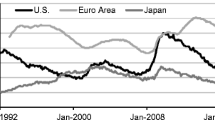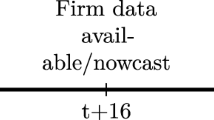Abstract
This article provides out-of-sample forecasts of Nevada gross gaming revenue (GGR) and taxable sales using a battery of linear and non-linear forecasting models and univariate and multivariate techniques. The linear models include vector autoregressive and vector error-correction models with and without Bayesian priors. The non-linear models include non-parametric and semi-parametric models, smooth transition autoregressive models, and artificial neural network autoregressive models. In addition to GGR and taxable sales, we employ recently constructed coincident and leading employment indexes for Nevada’s economy. We conclude that the non-linear models generally outperform linear models in forecasting future movements in GGR and taxable sales.
Similar content being viewed by others
References
Banerji A, Dua P, Miller SM (2006) Performance evaluation of the new Connecticut leading employment index using lead profiles and BVAR models. J Forecast 25: 415–437
Bhardwaj G, Swanson NR (2006) An empirical investigation of the usefulness of arfima models for predicting macroeconomic and financial time series. J Econ 131(1-2): 539–578
Bishop CM (1995) Neural networks for pattern recognition. Oxford University Press, Oxford
Cargill TF, Eadington WR (1978) Nevada’s gaming revenue: time characteristics and forecasting. Manag Sci 24: 1221–1230
Cargill TF, Morus SA (1988) A vector autoregressive model of the Nevada economy. Federal Reserve Bank of San Francisco Economic Review Winter, pp 21–32
Cargill TF, Raffie K (1990) The Nevada VAR model: update and general observations. Nevada Rev Bus Econ 14: 2–9
Clark TE, McCracken MW (2001) Tests of equal forecast accuracy and encompassing for nested models. J Econ 105(1): 85–110
Cybenko G (1989) Approximation by superposition of sigmoidal functions. Math Control Signals Syst 2: 303–314
De Gooije JG, Vidiella-i-Anguera A (2004) Forecasting threshold cointegrated systems. Int J Forecast 20: 237–253
Deschamps PJ (2008) Comparing smooth transition and Markov switching autoregressive models of US unemployment. J Appl Econ 23(4): 435–462
Dickey DA, Jansen DW, Thornton DL (1991) A primer on cointegration with an application to money and income. Federal Reserve Bank St. Louis Rev 73: 58–78
Doan TA, Litterman RB, Sims CA (1984) Forecasting and conditional projections using realistic prior distributions. Econ Rev 3: 1–100
Dua P, Miller SM (1996a) Forecasting and analyzing economic activity with coincident and leading indexes: The case of Connecticut. J Forecast 15: 509–526
Dua P, Miller SM (1996b) Forecasting Connecticut Home Sales in a BVAR framework using coincident and leading indexes. J Real Estate Financ Econ 13: 219–235
Dua P, Ray SC (1995) A BVAR model for the Connecticut economy. J Forecast 14: 167–180
Eisendrath D, Bernhaerd BJ, Lucas AF, Murphy DJ (2008) An analysis of the effects of September 11, 2001, on Las Vegas strip gaming volume. Cornell Hosp Q 49: 145–162
Fahlman SE (1988) Faster-learning variations on back-propagation: an empirical study. In: Touretsky D, Hinton GE, Sejnowski TJ (eds) Proceedings of the 1988 Connectionist Models Summer School. Morgan Kaufmann, San Mateo, pp 38–51
Fausett L (1994) Fundamentals of neural networks. Prentice-Hall, Upper Saddle River
Fine TL (1999) Feedforward neural network methodology. Springer, Berlin
Foresee FD, Hagan MT (1997) Gauss–Newton approximation to Bayesian regularization. In: IEEE international conference on neural networks, vol 3. IEEE, New York, pp 1930–1935
Funahashi K (1989) On the approximate realization of continuous mappings by neural networks. Neural Netw 2: 183–192
Hansen JV, McDonald JB, Nelson RD (1999) Time series prediction with genetic-algorithm designed neural networks: An empirical comparison with modern statistical models. Comput Intell 15: 171–184
Hayfield T, Racine JS (2008) Nonparametric econometrics: the np package. J Stat Softw 27: 1–32
Hornik K, Stinchombe M, White H (1989) Multilayer feed-forward networks are universal approximators. Neural Netw 2: 359–366
Johansen S (1995) Likelihood-based inference in cointegrated vector autoregressive models. Oxford University Press, Oxford
Kaastra I, Boyd M (1996) Designing a neural network for forecasting financial and economic time series. Neurocomputing 10: 215–236
Lachtermacher G, Fuller JD (1995) Backpropagation in time-series forecasting. J Forecast 14: 381–393
LeSage JP (1999) Applied econometrics using MATLAB. http://www.spatial-econometrics.com
Lisi F, Schiavo RA (1999) A comparison between neural networks and chaotic models for exchange rate prediction. Comput Stat Data Anal 30: 87–102
Litterman RB (1981) A Bayesian procedure for forecasting with vector autoregressions. Working Paper, Federal Reserve Bank of Minneapolis
Litterman RB (1986) Forecasting with Bayesian vector autoregressions—five years of experience. J Bus Econ Stat 4(1): 25–38
Lundbergh S, Terasvirta T (2002) Forecasting with smooth transition autoregressive models. In: Clements MP, Hendry DF (eds) A companion to economic forecasting. Blackwell, Oxford, pp 485–509
Luukkonen R, Saikkonen P, Terasvirta T (1988) Testing linearity against smooth transition autoregressive models. Biometrika 75: 491–499
MacKay DJC (1992) A practical Bayesian framework for backpropagation networks. Neural Comput 4: 448–472
Marcellino M (2002) Instability and non-linearity in the EMU. Discussion Paper No. 3312, Centre for Economic Policy Research
Marcellino M (2004) Forecasting EMU macroeconomic variables. Int J Forecast 20: 359–372
Masters T (1993) Practical neural networks recipes in C++. Academic Press, London
Milas C, Naraidoo R (2012) Financial market conditions, real time, nonlinearity and european central bank monetary policy: in-sample and out-of-sample assessment. Comput Stat Data Anal 56(1): 173–189
Montgomery A, Zarnowitz V, Tsay R, Tiao G (1998) Forecasting the U.S. unemployment rate. J Am Stat Assoc 93: 478–493
Naraidoo R, Paya I Forecasting monetary rules in South Africa. Int J Forecast (forthcoming)
Newey WK, West KD (1987) A simple, positive semi-definite, heteroskedasticity and autocorrelation consistent covariance matrix. Econometrica 55: 703–708
Niemira MP, Klein PA (1994) Forecasting financial and economic cycles. Wiley, New York
Opsomer J, Wang Y, Yang Y (2001) Nonparametric regression with correlated errors. Stat Sci 16: 134–153
Psaradakis Z, Ravn MO, Sola M (2005) Markov switching causality and the money—output relationship. J Appl Econ 20: 665–683
Ripley BD (1996) Pattern recognition and neural networks. Cambridge University Press, Cambridge
Rothman P (1998) Forecasting asymmetric unemployment rates. Rev Econ Stat 80: 164–168
Rothman P, van Dijk D, Hans P (2001) Multivariate STAR analysis of money-output relationship. Macroecon Dyn 5(4): 533–576
Rumelhart DE, Hinton GE, Williams RJ (1986) Learning internal representations by error propagation. In: Rumelhart DE, McClelland JL (eds) Parallel distributed processing. MIT Press, Cambridge, pp 318–362
Rzempoluck EJ (1998) Neural network data analysis using simulnet. Springer, New York
Sarle WS (2002) Neural network FAQ. Retrieved 28 May 2010. ftp://ftp.sas.com/pub/neural/FAQ.html
Shonkwiler JS (1992) A structural time series model of Nevada gross taxable gaming revenue. Rev Reg Stud 22: 239–249
Sims CA (1980) Macroeconomics and reality. Econometrica 48(1): 1–48
Sims CA, Stock JH, Watson MW (1990) Inference in linear time series models with some unit roots. Econometrica 58: 113–144
Smith M (1993) Neural networks for statistical modeling. Van Nostrand Reinhold, New York
Spencer DE (1993) Developing a Bayesian vector autoregression model. Int J Forecast 9(3): 407–421
Stern HS (1996) Neural networks in applied statistics. Technometrics 38: 205–220
Stock JH, Watson MW (1999) A comparison of linear and nonlinear univariate models for forecasting macroeconomic time series. In: Engle R, White H (eds) Cointegration, causality and forecasting. A festschrift in Honour of Clive W. J. Granger. Oxford University Press, Oxford, pp 1–44
Swanson NR, White H (1995) A model-selection approach to assessing the information in the term structure using linear models and artificial neural networks. J Bus & Econ Stat 13: 265–275
Swanson NR, White H (1997) A model-selection approach to real-time macroeconomic forecasting using linear models and artificial neural networks. Rev Econ Stat 79: 540–550
Terasvirta T (1998) Modelling economic relationships with smooth transition regressions. In: Ullah A, Giles DEA (eds) Handbook of applied economic statistics. Marcel Dekker, New York, pp 507–552
Terasvirta T (2006) Forecasting economic variables with nonlinear models, In: Elliott G, Granger CWJ, Timmermann A (eds) Handbook of Economic Forecasting, Elsevier, Amsterdam pp 413–457
Terasvirta T, Dijk D, Medeiros MC (2005) Linear models, smooth transition autoregressions, and neural networks for forecasting macroeconomic time series: a re-examination. Int J Forecast 21(4): 755–774
Todd RM (1984) Improving economic forecasting with Bayesian vector autoregression. Fed Res Bank Minneapolis Quar Review Fall 18–29
Tsay RS (1998) Testing and modeling multivariate threshold models. J Am Stat Accof 93: 1188–1202
US Department of Commerce (1977) Composite indexes of leading, coincident, and lagging indicators: A brief explanation of their construction. In: Handbook of Cyclical Indicators, A Supplement to the Business Conditions Digest. Bureau of Economic Analysis, Washington, DC, pp 73–76
US Department of Commerce (1984) Composite indexes of leading, coincident, and lagging indicators: A brief Explanation of their construction. In: Handbook of Cyclical Indicators, A Suplement to the Business Conditions Digest. Bureau of Economic Analysis, Washington, DC, pp 65–70
van Dijk D, Terasvirta T, Franses PH (2002) Smooth transition autoregressive models—a survey of recent developments. Econ Rev 21: 1–47
Wasserman PD (1989) Neural computing: theory and practice. Van Nostrand Reinhold, New York
White H (1988) Economic prediction using neural networks: the case of IBM stock prices. In: Proceedings of the second annual IEEE conference on neural networks, vol II. IEEE Press, New York, pp 451–458
White H (1989) Some asymptotic results for learning in single hidden-layer feedforward network models. J Am Stat Assoc 84: 1003–1013
Zellner A, Palm F (1974) Time series analysis and simultaneous equation econometric models. J Econ 2: 17–54
Author information
Authors and Affiliations
Corresponding author
Rights and permissions
About this article
Cite this article
Balcilar, M., Gupta, R., Majumdar, A. et al. Forecasting Nevada gross gaming revenue and taxable sales using coincident and leading employment indexes. Empir Econ 44, 387–417 (2013). https://doi.org/10.1007/s00181-011-0536-2
Received:
Accepted:
Published:
Issue Date:
DOI: https://doi.org/10.1007/s00181-011-0536-2




